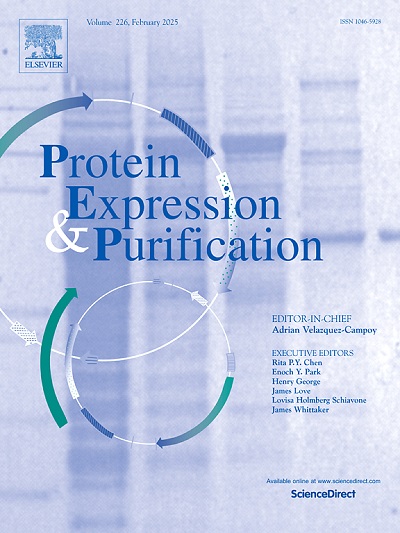拟南芥内在失调蛋白SOG1的纯化与特性研究。
IF 1.2
4区 生物学
Q4 BIOCHEMICAL RESEARCH METHODS
引用次数: 0
摘要
SOG1是一种由折叠的NAC (NAM-ATAF-CUC2)结构域和内在无序的c端结构域(CTD)组成的转录因子,在植物中协调DNA损伤反应。本文比较了不同表达和纯化重组全长拟南芥SOG1的方法。Sf9昆虫细胞中的表达产生一种蛋白,该蛋白含有一个磷酸化位点,可能位于CTD的T423位点。据报道,该位点在铝毒性胁迫下在植物中被磷酸化,并可能以尚未确定的方式影响SOG1的转录活性。SOG1在大肠杆菌BL21 (DE3)中的表达导致包涵体的形成,这一问题通过使用可切割的SUMO溶解度标签来解决。产生的蛋白没有磷酸化,代表SOG1的转录失活状态。两种蛋白制备均表现出相似的CD光谱和熔化温度。SEC-MALS测定这些蛋白与其他NAC转录因子一样,在溶液中形成二聚体。这两种蛋白质也高度非球形,通过分析SEC确定,并且可能由于其无序的CTD而被拉伸。在电迁移转移实验中,昆虫和大肠杆菌纯化的SOG1蛋白与SOG1的靶基因SMR5的启动子区域的DNA片段结合,显示出两种纯化蛋白的功能。本文章由计算机程序翻译,如有差异,请以英文原文为准。
Purification and characterization of the intrinsically disordered Arabidopsis thaliana protein SOG1
SOG1, a transcription factor consisting of a folded NAC (NAM-ATAF-CUC2) domain and an intrinsically disordered C-terminal domain (CTD), co-ordinates the DNA damage response in plants. Here we compare different methods to express and purify recombinant full length Arabidopsis thaliana SOG1. Expression in Sf9 insect cells results in a protein that contains a phosphorylated site that is possibly located on the T423 site in the CTD. This site is reported to be phosphorylated in planta upon aluminium toxicity stress and may affect the transcriptional activity of SOG1 in an yet undetermined way. Expression of SOG1 in E. coli BL21 (DE3) leads to the formation of inclusion bodies, a problem that is resolved by using a cleavable SUMO solubility tag. The resulting protein is not phosphorylated and represents the transcriptional inactive state of SOG1. Both protein preparations show similar CD spectra and melting temperatures. SEC-MALS determined that the proteins, like other NAC transcription factors, form a dimer in solution. Both proteins are also highly non-globular as determined by analytical SEC and are likely stretched out due to their disordered CTD. In electromobility shift assays, both insect and E. coli purified SOG1 proteins bind to a DNA fragment from the promoter region of SMR5, a well established target gene of SOG1, showing the functionality of both purified proteins.
求助全文
通过发布文献求助,成功后即可免费获取论文全文。
去求助
来源期刊

Protein expression and purification
生物-生化研究方法
CiteScore
3.70
自引率
6.20%
发文量
120
审稿时长
32 days
期刊介绍:
Protein Expression and Purification is an international journal providing a forum for the dissemination of new information on protein expression, extraction, purification, characterization, and/or applications using conventional biochemical and/or modern molecular biological approaches and methods, which are of broad interest to the field. The journal does not typically publish repetitive examples of protein expression and purification involving standard, well-established, methods. However, exceptions might include studies on important and/or difficult to express and/or purify proteins and/or studies that include extensive protein characterization, which provide new, previously unpublished information.
 求助内容:
求助内容: 应助结果提醒方式:
应助结果提醒方式:


